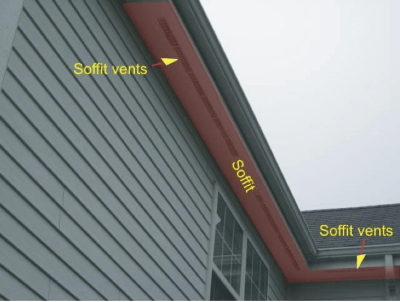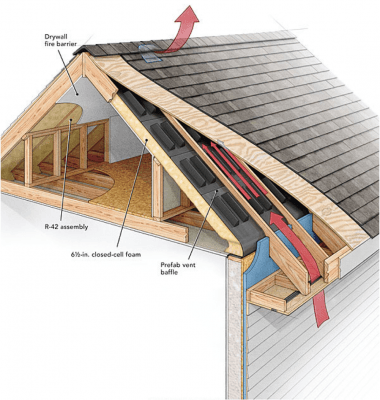Roof Ventilation and Summer Attic Heat
Roof ventilation is crucial for maintaining a cool home. Oklahoma’s summers are notoriously hot. You may have noticed your home is warmer than usual, especially your attic. Walking into your attic during the summer can feel like an oven.
Wondering what can help cool down your attic in those hot summer months? A roof ventilation system is your answer.
How roof ventilation works
Roof ventilation allows air to circulate through your attic space. Intake fans draw cooler air from outside into the attic. Exhaust vents push the warmer air out of the attic. This keeps a continuous flow of air in and out of the attic. This prevents hot air and moisture from getting trapped in the attic.
The two different types of roof ventilation systems are active and passive. Active ventilation systems manually draw and expel air through the attic. These systems are typically electrically powered. Passive ventilation systems utilize wind to circulate the air.
Why roof ventilation is important
Proper ventilation is vital for your home. As we mentioned, the primary reason for roof ventilation is to keep the temperature in your attic regulated. This helps lower the home’s overall temperature, saving energy and lessening the strain on your air conditioner.
Attic ventilation also prevents moisture build-up. Moisture can build up in your attic from the elements and daily activities in your home. Trapped moisture can lead to mold growth and structural damage to your home.
Excessive heat and moisture will also shorten the lifespan of your roof. Proper ventilation mitigates these issues and preserves the integrity of your roof, delaying the need for repairs and replacements.
The different types of roof ventilation or roof vents
The first thing we do when we go out on a call about concern over too much heat in the attic is to look at the type of roof ventilation someone has on their home. This can vary with age, style and expense of a home.
Most older homes have a roof with wood shakes (shingles). Wood naturally does a better job at buffering heat than asphalt shingles. However, asphalt shingles are the more efficient roofing that we use in the roofing industry today. Eventually, most people with wood shingles end up transitioning to asphalt shingle roofs. What tends to happen is that the first summer after they’ve made the transition they notice that they have trouble keeping their house cool.
Think of a roof like a car engine. There needs to be an intake and an exhaust (in our case, a vent) to allow heat to escape. Available roof ventilation types depend on the style of the roof. Some of the most common roof vents include:
Soffit vents
Soffit vents are the actual vents in the eves of your home. These intake vents work particularly well when paired with ridge vents. You are likely to see these vents in the majority of homes.

Photo Credit: www.checkthishouse.com
Roof ridge vents
Ridge vents are one of the most popular choices of exhaust vents. These low-profile vents are placed along the peak of your roof. However, this means they can’t be placed on flat roofs.
First, when we add a ridge vent, we remove the shingles off the top of the roof ridge and cut the plywood back. Then, we place a plastic covering that allows air to flow through the peak of the ridge. Lastly, we put shingles back over the plastic covering. You can’t see it, but the air then flows out through the peak of the ridge.
Gable vents
Gable vents are a type of vent that can only be placed on a gable roof. They are installed on either side of the roof near the peaks and utilize cross-ventilation to circulate air in the attic. They are available in various shapes and sizes and add a decorative element to your home.
Turbine vents
Turbine vents, commonly known as whirlybirds, rely on wind power for operation. The wind spins the turbine, drawing out the hot air. However, they are ineffective on windless days.
Box vents
Box vents are compact vents strategically placed on your roof. Their compact size allows them to be placed where air ventilation is required but the space is not large enough for another type of vent. While size allows for more flexibility, they may not be as effective as another type of vent.
Powered attic vents
Powered attic vents rely on electric or solar power to draw hot air out of the attic. These vents are ideal for homes without a natural airflow. Solar-powered attic ventilation systems are a popular option because they reduce electric costs and are environmentally friendly.
Exhaust roof vents
There are different types of exhaust roof or attic vents. Essentially, they all work by allowing the heat to escape. If you don’t have an exhaust vent, then the hot air builds up throughout the day and makes both your attic and roof extremely hot. This same hot air then leaks back into the home, which makes it more difficult for your air conditioning to keep your house cool.

Photo credit: Fine Home Building
Turner Roofing professionals will come out and physically assess whether or not your roof has proper ventilation and offer a free estimate.
Improving roof ventilation
The solution to roof ventilation depends on many factors. Turner Roofing experts will assess your home and determine if you need more intake or exhaust fans or a combination of both. Additionally, we recommend speaking with an insulation specialist. Proper insulation will protect heat from seeping into the attic and prevent cold air from leaving your home.
Additionally, we suggest to homeowners to consult with an insulation specialist. Insulation is key for two things. First, it keeps heat from seeping into the home from the attic. Also, insulation keeps cold air inside the home rather than leaking into the attic. Most of the time, the insulation specialists (similar to us at Turner Roofing) will come out and give you a free estimate.
If you have noticed your attic is exceptionally warm this summer, and if you’re having trouble keeping your house cool, give Turner Roofing a call. Our roofing experts will examine your roof and provide a free estimate on how to improve your roof ventilation. Contact us today.